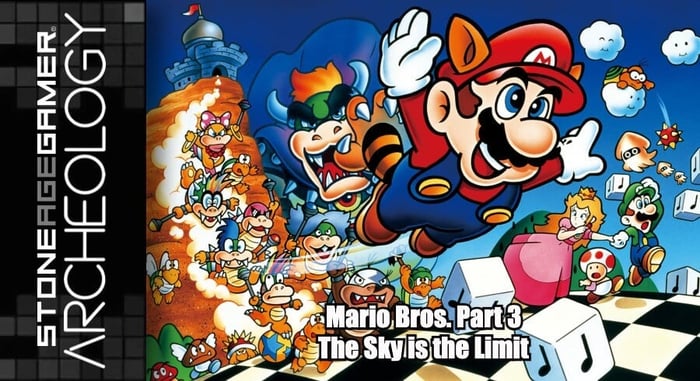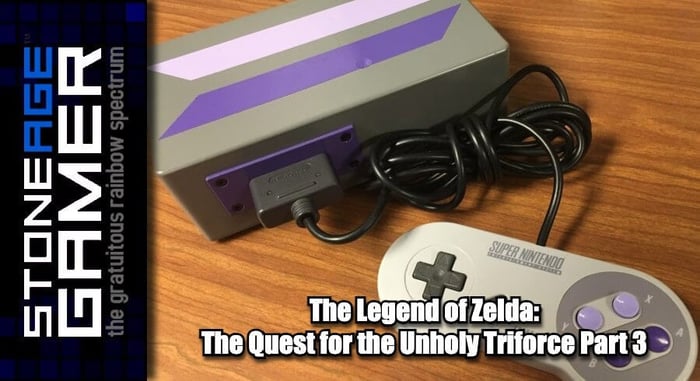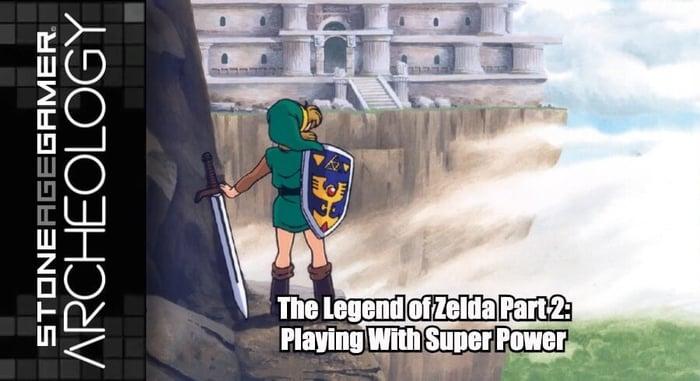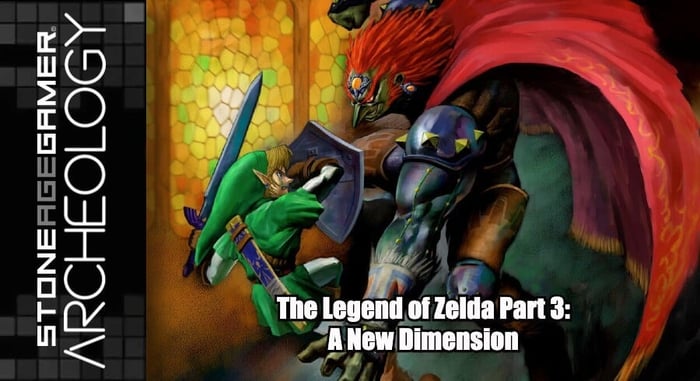
The Legend of Zelda Retrospective Part 1 - A Long, Long Time Ago...
Welcome to Part 1 of our 8-part Zelda retrospective, and the very first episode of Stone Age Gamer: Archeology. In this series, we aim to tell the story of the Zelda series as it unfolded for North American audiences. We are not only looking at the games themselves, but the historical context surrounding them. In our first episode, we cover the origins of the series and how it evolved during its first few years on the market.
A note about this series. This project was heavily inspired by the old GameTrailers Retrospectives, which I love with all my heart. They're unfortunately pretty outdated now, so I've decided to take a crack at filling that void. As a nod to anyone who watched their wonderful Zelda retrospective series, I used the same Zelda Symphony music they did in their first episode because it fills me with nostalgic joy. I hope you enjoy the premiere episode, and come back for the rest as I make them.
-Kris
Transcript of the video:
A long, long time ago, video games were simple. By and large, arcade and home console games were all about fast paced, pick up and play games that focused on points. But even in those old days, the people who made games frequently searched for ways to make them something more.
In the late 70s and early 80s in the US, home video games were the Atari 2600. Competitors existed, but the bulk of the video game mindshare was focused on Atari’s woodgrain machine, and this was largely thanks to its popular home conversions of arcade hits. But even here, those high scores slowly began giving way to more complex titles like Adventure, SwordQuest, and Raiders of the Lost Ark. These games focused on completing specific objectives not for points, but to quote unquote beat the game. Of course lots of games like this were cropping up elsewhere in the world, even in the US on home computers, but for the console gamer, these games were their first taste of what was to come.
Unfortunately, the US gaming market crashed, and players looking forward to the next big thing in terms of video game evolution were out of luck. At least, until Nintendo arrived.
The Nintendo Entertainment System, or NES, was largely responsible for revitalizing the North American video game market coupled with Super Mario Bros., a game that looked, played, and sounded lightyears beyond anything the home console market had to offer before it. It took off in a big way, but little did NES owners know Super Mario Bros. was just the tip of the iceberg. Over in Japan, the Famicom, the Japan equivalent to the NES, had already outgrown Super Mario Bros. The introduction of the Famicom Disk System gave players overseas access to games that had evolved beyond even Super Mario’s abilities.
Back in the states though, the Disk System never made it to market thanks to the introduction of special chips that allowed game makers to create larger scale adventures without the need for new hardware. These games largely started making their way to the US in 1987, where our story begins.
Video games were indeed starting to change. Games like Konami’s Castlevania, Tecmo’s Rygar, and Capcom’s Trojan kicked off 1987 on the platform by introducing players to new worlds with considerably more depth than most of what had come before them. Nintendo themselves hammered this evolution of console games home through a trio of releases. Kid Icarus, Metroid, and arguably the most influential of all, The Legend of Zelda. While Kid Icarus and Metroid broke with Nintendo’s traditional Black Box branding with silver backdrops denoting that they were “Password Packs” The Legend of Zelda took things a step further. Zelda came in gold, and not just the box, but the cartridge itself.
The Legend of Zelda was special, and Nintendo knew this thanks to the game’s pre-existing success in Japan. They began communicating this with players in a number of ways. Their official publication the Nintendo Fun Club Newsletter featured Zelda as its cover story on both its second and third issues. Combining that with TV commercials, and word of mouth from those who had managed to play it at trade shows or in its native country Japan, the game had all the makings of an instant hit. The Legend of Zelda was finally released in the US in August 1987, and as expected was instantly one of the most popular titles on the platform. But even if you had managed to see all this beforehand, the magazine articles, the shiny box, the commercials, nothing could have prepared players for that first moment they plugged their gold cartridges into their NES consoles and powered them on.
Where for the most part title screens were accompanied by little more than a few options and maybe a catchy jingle, The Legend of Zelda instantly transported players to a mystical new world. Even Nintendo’s own Kid Icarus and Metroid title screens, for as great as they were, couldn’t match the unbelievable feeling that Zelda gave off. That you were about to embark on something truly new.
This continued the moment you pressed start and were prompted to create a save file. The Legend of Zelda was the first NES game to feature battery backed saves, so you didn’t have to try and finish the entire adventure in one sitting. This was something that computer games had been able to do for a while, but for home console players in the US sitting in front of their televisions, this was a revelation that can not be overstated. Saving your progress now is a given, but back in 1987, it changed everything.
The Legend of Zelda was more than just in-depth. Like Super Mario Bros before it, Zelda delivered in every way a video game could back then. The visuals were attractive and ran smoothly. The sound effects were memorable and suited the gameplay perfectly from the sound of a bomb exploding to the roars of boss characters coming from the next room. The music too was a revelation, with Koji Kondo’s compositions eliciting a sense of adventure and mystery at every turn, filling players ears with a level of musical composition that very few games before it had even come close to.
Zelda also came with lore, and lots of it. The game itself tells a brief version of the story, but if you opened the included instruction manual, you were treated to a gorgeously illustrated look into the events that put protagonist Link in the position he found himself in in the first place.
The land of Hyrule was in despair. An evil army led by Ganon had stolen The Triforce of Power, a piece of a mystical and all-powerful relic. Its counterpart, The Triforce of Wisdom belonged to Princess Zelda, who Ganon had kidnapped in order to gain control of both Triforces. Zelda was smart though, because she managed to break the Triforce of Wisdom into eight fragments and spread them across the land.
She entrusted her nursemaid Impa with finding a hero who would travel across Hyrule, gather the Triforce pieces together, and defeat Ganon once and for all. She found a young boy named Link who came to her aid when she was attacked by monsters, and thus began the adventure. And what an adventure it was. With a sprawling overworld and 9 underground labyrinths to explore, The Legend of Zelda confronted players with a quest far more complex than anything they had faced before. Fortunately there were also a number of tools that could help Link on his quest. A boomerang to stun enemies, keys to open doors, new tunics to increase his defense, and of course, an enchanted arrow imbued with the power to destroy Ganon. It was a massive undertaking, but one that resonated with players enough to kick off the beloved franchise it is today. The game came with a mini strategy guide, but it only scratched the surface. Players everywhere created their own maps with pen and paper, and told one another about the secrets they found throughout their adventure. Hidden optional items were scattered everywhere, which only helped increase the level of interest players had in sharing their experiences. There was even a second quest that rearranged the map and increased the difficulty for those clever enough to actually finish the game, which itself was a daunting task. The Legend of Zelda, on the surface, appeared open and inviting, but there was no clear direction on where to go. Not only was it easy to get lost in the game’s massive open world, but the monsters and puzzles within were incredibly challenging.
In spite of its challenge, or perhaps even because of it, The Legend of Zelda was a massive success. It redefined what a console game could be, and continued to propel Nintendo’s popularity into the stratosphere, but it was about to face its first real test. How do you follow up a game like The Legend of Zelda? Apparently, you go back to the drawing board.
Zelda II: The Adventure of Link was released in September 1988 and was anything but what Zelda fans expected. Almost every aspect of the game had changed. It was a side scrolling action platformer instead of a top down action adventure. It focused on in-depth combat over puzzle solving. But just because it was different, didn’t necessarily mean it was bad.
The standards set in the first game for audio and visual design were well maintained for the sequel. The sound effects were more visceral than ever with Link letting out an audible grunt when he takes damage, and the memorable sound of a shield blocking a sword can no doubt still be heard in the minds of players of a certain age today. The music this time was composed by Akito Nakatsuka and complimented the game’s more action-based style. The graphics were considerably more intricate, featuring increased details and animations for Link and the various monsters he encounters. And speaking of monsters, the bestiary was more dangerous than ever with enemies approaching Link with complex attack patterns, and higher offensive and defensive capabilities. Every dungeon consisted of unique tilesets and featured its own distinct boss. Link could learn new moves like the Jump and Downward Thrust maneuvers, and in addition to new weapons and tools, Link could utilize magic spells to help him along on his quest.
Even Hyrule itself was more expansive and alive than ever before, featuring multiple landmasses to explore and a number of towns spread across them. Each one full of its own citizens, secrets, and history.
This expansion also applied to the game’s lore, which went deeper than before. The instruction manual featured even more detailed illustrations and a story that directly followed up on the events of the original game. After defeating Ganon, Link returned to Hyrule castle to find the land once again in peril. Ganon’s minions were determined to resurrect their fallen king by killing Link and using his blood in a revival ritual. Link had been doing his part to help fend off the monsters, but around his 16th birthday the mark of not two, but three triangles appeared on his hand. When Link went to ask Impa about it, she told him what at the time was known as the actual Legend of Zelda. The princess you saved in the first game was only one of many princesses given that name over the years. One such princess had been cursed ages ago, and the key to waking her up was also the key to preventing Ganon’s return. By returning crystals to several statues hidden across the land Link could gain access to a heretofore unmentioned third Triforce, the Triforce of Courage, which when united with the Triforces of Power and Wisdom would unleash their full potential. This, players would learn, was no easy task.
The Legend of Zelda was by no means an easy game, but by comparison, Zelda II made it look like a cakewalk. The aforementioned battle system required a level of play that the first game rarely approached, with the difficulty ratcheting up to an absurd degree by the time Link reached the final palace.
Difficulty and genre shift aside, Zelda II was also a huge hit for Nintendo. It introduced a number of series mainstays like the manual stating Link is left handed, several names of areas in the game showing up later in the series, a magic system, and the all-important third Triforce. Its success also cemented Zelda as one of Nintendo’s most important brands right next to the likes of Mario and Donkey Kong. Zelda was here to stay, and players couldn’t wait to see what was next for the hero of Hyrule.
But just like Zelda II, Link’s next adventure wasn’t quite what they expected.
In August 1989, Link embarked on his first handheld adventure in a game simply called Zelda. This was a dual screen Game & Watch game that drew its inspiration from both The Legend of Zelda and Zelda II: The Adventure of Link.
According to the game’s manual, Hyrule has been harassed by eight dragons, who have somehow kidnapped Zelda and now each possess a shard of the Triforce of Wisdom. Link has to track them down and rescue the princess from evil once again.
Its outward appearance bares more of a resemblance to the first game with Link’s artwork depicting him with a more squat appearance and crossed swords similar to the ones seen on the first game’s title screen. However, the gameplay itself is more in line with Zelda II in that it plays out from a 2D perspective. Link has to face off against goblins in a similar fashion to how he fought in Zelda II, except now he has to contend with Stalfos trying to stab him from a lower level during battle. Each goblin you defeat will open up a staircase that leads to another chamber with another goblin. Eventually you will come across the correct staircase to face off against a dragon. Defeat a dragon and you get a Triforce piece added to your inventory. Reunite the Triforce in full and Zelda will be free.
While not unsuccessful by any means, the Zelda Game & Watch didn’t have nearly the same impact as its console counterparts. Still, the idea of taking Zelda on the go was an enticing one, and fans who managed to get their hands on one no doubt enjoyed themselves.
What did make an impact though, came just one month later. In September 1989, the first episode of The Super Mario Bros. Super show aired in the US, bringing Nintendo’s plumbing mascot to TV screens across the country every weekday after school. Monday through Thursday, the Super Mario Bros. Super Show featured bizarre live-action segments starring Mario and Luigi portrayed by professional wrestler Captain Lou Albano and Canadian character actor Danny Wells. These segments introduced animated episodes of the Super Mario Bros. cartoons. Every Friday though, they changed things up by airing an episode of a Legend of Zelda cartoon instead. The show played pretty fast and loose with the established lore, but featured loads of music and sound effects from the game. It wasn’t perfect, but it captured the imaginations of kids everywhere, and coined the memorable catchphrase “Well Excuse me princess.”
One month after the debut of the Super Mario Bros. Super Show, Nintendo and Nelsonic Technologies released Link’s second portable adventure, this time in the form of the Legend of Zelda Game Watch. Not to be confused with the Zelda Game & Watch, The Legend of Zelda Game Watch was an LCD game stuffed into a literal wristwatch.
Considerably more simplistic than even the Game & Watch game, this game features very little by way of story. Basically Link enters a cave for some reason and has to fend off bats and iron balls before defeating a dragon that clearly resembles Aquamentus from the original Legend of Zelda on NES. Each dragon you defeat gains you one more Triforce piece, and you play until either you collect them all or you die. Zelda doesn’t appear to be involved in this game at all.
It’s pretty basic, but it did return Zelda to its original overheard perspective, which gave players a sense that they were playing a genuine portable version of the game they loved.
Zelda being on a watch was just one of many things that showed that By this point, Zelda had permeated popular culture in nearly every way Nintendo and Mario had. Bed sheets, garbage cans, t-shirts, anything Nintendo could license, they slapped Zelda and/or Mario onto. The Zelda franchise was riding high, and fans wanted more. The Zelda cartoon ran for 13 episodes, and in 1990 Valiant comics picked up the rights to create and distribute comic books based on Nintendo properties, including The Legend of Zelda. These comics resembled the cartoon series in a lot of ways including its portrayal of Zelda as more of Link’s equal, and dressing her in a more action-ready outfit instead of the game series dresses and tiaras. But it told unique stories that drew inspiration from the games.
For as great as all this was for Zelda fans though , what they wanted was a new game. Not an LCD handheld, not a wristwatch, but the next great evolution of the series. They would have to wait another two years, but in 1992, Nintendo delivered not just one of the best sequels fans could have hoped for, but one of the best games ever made.
Join us next time when Nintendo plays with power, Super power, and we see some of the series highest highs, as well as its lowest lows.





